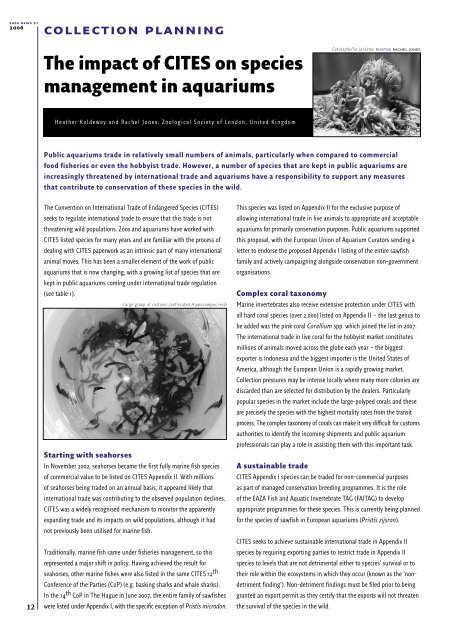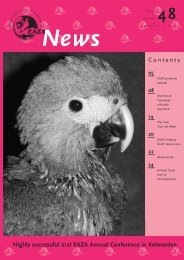Year of the Frog - European Association of Zoos and Aquaria
Year of the Frog - European Association of Zoos and Aquaria
Year of the Frog - European Association of Zoos and Aquaria
Create successful ePaper yourself
Turn your PDF publications into a flip-book with our unique Google optimized e-Paper software.
eaza news 61<br />
2008 collection planning<br />
12<br />
The impact <strong>of</strong> CITES on species<br />
management in aquariums<br />
Hea<strong>the</strong>r Koldewey <strong>and</strong> Rachel Jones, Zoological Society <strong>of</strong> London, United Kingdom<br />
Public aquariums trade in relatively small numbers <strong>of</strong> animals, particularly when compared to commercial<br />
food fisheries or even <strong>the</strong> hobbyist trade. However, a number <strong>of</strong> species that are kept in public aquariums are<br />
increasingly threatened by international trade <strong>and</strong> aquariums have a responsibility to support any measures<br />
that contribute to conservation <strong>of</strong> <strong>the</strong>se species in <strong>the</strong> wild.<br />
The Convention on International Trade <strong>of</strong> Endangered Species (CITES)<br />
seeks to regulate international trade to ensure that this trade is not<br />
threatening wild populations. <strong>Zoos</strong> <strong>and</strong> aquariums have worked with<br />
CITES listed species for many years <strong>and</strong> are familiar with <strong>the</strong> process <strong>of</strong><br />
dealing with CITES paperwork as an intrinsic part <strong>of</strong> many international<br />
animal moves. This has been a smaller element <strong>of</strong> <strong>the</strong> work <strong>of</strong> public<br />
aquariums that is now changing, with a growing list <strong>of</strong> species that are<br />
kept in public aquariums coming under international trade regulation<br />
(see table 1).<br />
Large group <strong>of</strong> customs confiscated Hippocampus reidi<br />
Starting with seahorses<br />
In November 2002, seahorses became <strong>the</strong> first fully marine fish species<br />
<strong>of</strong> commercial value to be listed on CITES Appendix II. With millions<br />
<strong>of</strong> seahorses being traded on an annual basis, it appeared likely that<br />
international trade was contributing to <strong>the</strong> observed population declines.<br />
CITES was a widely recognised mechanism to monitor <strong>the</strong> apparently<br />
exp<strong>and</strong>ing trade <strong>and</strong> its impacts on wild populations, although it had<br />
not previously been utilised for marine fish.<br />
Traditionally, marine fish came under fisheries management, so this<br />
represented a major shift in policy. Having achieved <strong>the</strong> result for<br />
seahorses, o<strong>the</strong>r marine fishes were also listed in <strong>the</strong> same CITES 12th Conference <strong>of</strong> <strong>the</strong> Parties (CoP) (e.g. basking sharks <strong>and</strong> whale sharks).<br />
In <strong>the</strong> 14th CoP in The Hague in June 2007, <strong>the</strong> entire family <strong>of</strong> sawfishes<br />
were listed under Appendix I, with <strong>the</strong> specific exception <strong>of</strong> Pristis microdon.<br />
Catalaphyllia jardenei photos rachel jones<br />
This species was listed on Appendix II for <strong>the</strong> exclusive purpose <strong>of</strong><br />
allowing international trade in live animals to appropriate <strong>and</strong> acceptable<br />
aquariums for primarily conservation purposes. Public aquariums supported<br />
this proposal, with <strong>the</strong> <strong>European</strong> Union <strong>of</strong> Aquarium Curators sending a<br />
letter to endorse <strong>the</strong> proposed Appendix I listing <strong>of</strong> <strong>the</strong> entire sawfish<br />
family <strong>and</strong> actively campaigning alongside conservation non-government<br />
organisations.<br />
Complex coral taxonomy<br />
Marine invertebrates also receive extensive protection under CITES with<br />
all hard coral species (over 2,000) listed on Appendix II – <strong>the</strong> last genus to<br />
be added was <strong>the</strong> pink coral Corallium spp. which joined <strong>the</strong> list in 2007.<br />
The international trade in live coral for <strong>the</strong> hobbyist market constitutes<br />
millions <strong>of</strong> animals moved across <strong>the</strong> globe each year – <strong>the</strong> biggest<br />
exporter is Indonesia <strong>and</strong> <strong>the</strong> biggest importer is <strong>the</strong> United States <strong>of</strong><br />
America, although <strong>the</strong> <strong>European</strong> Union is a rapidly growing market.<br />
Collection pressures may be intense locally where many more colonies are<br />
discarded than are selected for distribution by <strong>the</strong> dealers. Particularly<br />
popular species in <strong>the</strong> market include <strong>the</strong> large-polyped corals <strong>and</strong> <strong>the</strong>se<br />
are precisely <strong>the</strong> species with <strong>the</strong> highest mortality rates from <strong>the</strong> transit<br />
process. The complex taxonomy <strong>of</strong> corals can make it very difficult for customs<br />
authorities to identify <strong>the</strong> incoming shipments <strong>and</strong> public aquarium<br />
pr<strong>of</strong>essionals can play a role in assisting <strong>the</strong>m with this important task.<br />
A sustainable trade<br />
CITES Appendix I species can be traded for non-commercial purposes<br />
as part <strong>of</strong> managed conservation breeding programmes. It is <strong>the</strong> role<br />
<strong>of</strong> <strong>the</strong> EAZA Fish <strong>and</strong> Aquatic Invertebrate TAG (FAITAG) to develop<br />
appropriate programmes for <strong>the</strong>se species. This is currently being planned<br />
for <strong>the</strong> species <strong>of</strong> sawfish in <strong>European</strong> aquariums (Pristis zijsron).<br />
CITES seeks to achieve sustainable international trade in Appendix II<br />
species by requiring exporting parties to restrict trade in Appendix II<br />
species to levels that are not detrimental ei<strong>the</strong>r to species’ survival or to<br />
<strong>the</strong>ir role within <strong>the</strong> ecosystems in which <strong>the</strong>y occur (known as <strong>the</strong> ‘nondetriment<br />
finding’). Non-detriment findings must be filed prior to being<br />
granted an export permit as <strong>the</strong>y certify that <strong>the</strong> exports will not threaten<br />
<strong>the</strong> survival <strong>of</strong> <strong>the</strong> species in <strong>the</strong> wild.

















